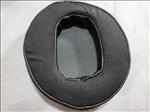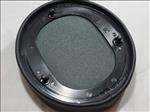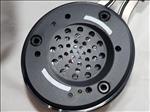
LucidSound LS50X
LucidSound is maker of many gaming headsets, available at a variety of pricepoints. Today we’re going to look at the LucidSound LS50X, which is made specifically for the Xbox line of consoles. The LS50X is a wireless gaming headset that is also capable of connecting to your phone via Bluetooth. We’ve tested a few headsets lately with this hybrid setup of connecting both to your computer or console and your phone. The LS50X’s versatility in letting you stream from either gives you some good flexibility on how to use it.
Let’s start with the design. The LS50X has two 50MM drivers that are under a memory foam earcup that also features a cooling gel to help mitigate heat from extended use. The cloth covering on the ear cups is nice and soft, offering a very comfortable feeling when sitting over the ear and on your head.

The earcups are easily removable with three plastic plugs holding them in. LucidSound sells replaceable earcups, so should the pleather starts to fall apart, you can easily replace them. I do appreciate the ease of replacement since I’ve had a few ear cups become worn and having an easy way to replace them is much appreciated.
A large metal band connects the two earcups together and I felt the top was pretty strong when trying to twist it. There’s not too much tension, and the band can stretch out a good ways if you have a wider head. The top of the headband has a nice soft covering with a moderate amount of padding. Each side can extend to accommodate different sizes of heads and the ear cups can rotate towards you to sit flat near your shoulders if you need them to rest on you.

Control wise, the right ear cup has the least amount of controls, with a rotating dial that doubles as a button and a Bluetooth/EQ button. On the left, you have the power button, USB-C connector, 3.5mm connector, removable mic, and another button dial.
The dials have a good, satisfying feel to them when they are rotated. They feature a smooth rotation with a not too strong resistance when dialing. Each dial has different functionality, depending on the mode. The left dial is primary for volume control for the main sound with the right cup letting you adjust chat volume.
The LS50X has two modes: Gaming and Bluetooth. The dial controls operate differently according to the mode you are in, which can take getting used to. Gaming mode lets you adjust the chat audio, gaming audio, and muting your mic or game sounds. It’s pretty much what you would expect from every other normal headset with controls.

Switching to Bluetooth mode - where you control your phone, for instance - the right dial will now let you skip to the next track or go to a previous track depending on which way you rotate it, accompanied by a voice telling you what's happening. The modes also determine what the dial buttons can do. In Bluetooth mode, pressing on the left ear cup will pause or play what’s currently playing. When not in Bluetooth mode, it can mute the audio coming through the headphones.
What’s nice is that the ability to quickly switch from Bluetooth mode or Gaming mode allows you to control aspects of each connected device, all at your fingertips. It’s especially helpful if you are streaming music from your phone while playing a game and want to pause, change tracks, or change volume of the stream. Changing the volume of the Bluetooth connection doesn’t affect the volume of the game audio and vice versa.
LucidSound advertised the included mic as being crystal clear, but I found it can be a little muffled at times. There are actually two mics on the LS50X, an internal mic and an attachable boom mic. The boom mic has a very nice flexible arm that can be easily positioned anywhere you want it. As you can probably deduce, the internal mic doesn’t sound nearly as good as the boom mic. If you want to use it in a pinch to take a call, it can work, but if you want to use it to game and talk with your friends, the boom mic is definitely preferable.

On default settings, my friends said I sounded a little muffled with the boom mic. LucidSound put in a way to turn off the filtering for the mics and disabling that helped the quality of my voice greatly. I sounded clearer, but with that comes the problem of hearing more environmental sound. My recommendation is to disable the voice filtering for the LS50X and perhaps use something like NVIDIA’s Broadcast app to help with filtering out environmental sounds.
When using a mic, the LS50X gives you the ability to hear your own voice (known as sidetone). For some, it’s nice to be able to hear themselves when talking. There isn’t a way to change the level of sidetone, as you can unfortunately only turn it on or off. But I think it’s a nice feature to have, and at least you can turn it off - unlike some other headsets I’ve tested with this feature.
Muting the mic is pretty simple. You can just push the right ear cup in Game mode, which produces a clicking sound to let you know you’ve pressed the mute button. A nice bright red light will come on at the end of the mic that’s easily visible, letting you know you’re muted. If you are using the internal mic, there’s just the audible cue when you press the button, but nothing to tell you if you’re muted or not. I would've liked a voice saying whether you’re muted or not when pressing the button, like when you change tracks on the LS50X and it tells you whether you are skipping or going to a previous track. It's a small nitpick, but I think it would’ve been a nice quality of life addition.

The one thing I did wish LucidSound would have included was a pop filter. I could easily hear myself breathing from both my nose and mouth, and sometimes when I would start talking and say certain words, I’d hear that wind-like sound that I’m sure annoys my friends. You can easily pick up some small pop filters to fit on the end of the mic, but I think LucidSound should have included this in the package.
If you do decide to not use the boom mic, LucidSound was nice enough to include a mic port cover. This little rubber piece covers up the mic connector to help with keeping it free from dust and dirt.
The LS50X is completely wireless, connecting to an included dongle that operates in the 2.4GHz band. Unlike the LS35X, you need the dongle to connect to the Xbox. Considering the LS50X is marketed as an Xbox specific headset, I did wonder why they didn’t go the same route for connection. For me, that’s OK though as the dongle lets me connect the LS50X to the PC and use it as a wireless gaming headset. It did take me a few tries for the mic to work on my PC for some reason, but plugging the LS50X dongle into my Xbox Series X, the entire setup worked perfectly right out of the gate.

Battery life is pretty great for the LS50X. While LucidSound said it is rated for 20 hours, I’ve found that it lasted about an hour longer without Bluetooth enabled. That’s really, really good and I’m glad the charging plug is USB-C. At 20+ hours, you’re going to last a few days of gaming most likely before you need to charge. You can easily check on the battery level by double tapping the left ear cup. A voice will let you know whether it’s high, medium or low. I personally would rather have the voice tell me what percentage the battery level is like some other headsets, but this works as well.
One problem I did run into was that the headset just wouldn’t turn off and none of the controls or buttons worked after a gaming session. Even trying to hold the power button to turn the LS50X off resulted in nothing. Thankfully, the easy fix is to take off the right ear cup and push a paper clip into the reset button and that fixed it right away. It’s a minor annoyance, and it doesn’t happen often. But I’ve seen other people on forums talking about this same issue, so it isn’t something that’s uncommon. It seems to happen when the headset fails turning itself off after there’s been no sound for a while. If I manually turned the headset off when I was done, I never ran into this issue. So keep in mind that the auto shut off might keep the LS50X from responding to controls, forcing you into the reset procedure.

For carrying around the LS50X, LucidSound also provides a very nice hard shell case in the package. It’s got a nice soft fabric that makes it comfortable to hold and keeps your headset safe. Inside is a nice little mesh pouch to keep all your accessories for the LS50X in. It’s a pretty slick addition to the package and it’s very capable of keeping the LS50X safe from harm in transit.
But how does the LS50X sound? To be honest, it sounds really, really good. The mids and highs come out really well. I was able to hear very subtle movements such as the footsteps of a creeping zombie in 7 Days to Die. Hearing little things like glass breaking or the ping of bullets ricocheting clearly really enhances the gaming experience. The explosions in games like Call of Duty and DOOM Eternal were strong, but not overpowering. The bass on the LS50X is what I would deem as punchy but not overwhelming.
For music and movies, the LS50X also excelled with really good sound reproduction. The few songs I listened to, the vocals came through clear and precise. Claps and instruments that produce a clicky clacky sound really shined with how well they sounded. As with gaming, I think the bass was good, but it’s not going to drown out the rest. Even with the EQ setting to emphasize bass, I didn’t think it made it too strong. Watching a few movies on Disney+, I was really liking how the LS50X handled positional audio. From the various sounds in the end battle of Avengers: Endgame, I was able to discern where things were coming from pretty well, as well as detecting subtle sounds that were off in the distance.

Speaking of EQ modes, there are five of them. From no EQ to bass boost, movie mode, game mode, and signature sound, to me they all didn’t sound too different except the no EQ mode was just louder than the rest. I kept switching modes over and over again, but I really couldn’t tell the differences. This was one of the few things I was disappointed in about the LS50X, but for me I’m not one that changes EQs that much so I wasn’t too put off by it.
For those that don’t want their headsets to just blast you with bass but do well all around in the sound department, the LS50X does a great job. I think it’s balanced really well in all areas and I really liked how it sounded in various applications. It’s comfortable to wear for long periods of time once you get used to it. For me it took a day or so, and the over the ear cups are quite soft even for someone like me who wears glasses. The LucidSound LS50X is priced at $190 which makes it one of the more expensive gaming headsets out there, but the features it has, sound quality, and comfortability makes it a good buy. I do wish it was more compatible with other consoles wirelessly, but you can always connect them with the included ⅜” cable should you want to use it on the PlayStation or the Switch. Overall, the LS50X is one of the better wireless Xbox headset out there and works quite well on the PC.
-Update 3/2/22- We got word from Lucidsound that the LS50X is $50 off and priced at $199.99 at the LucidSound website.
Rating: 8.8 Class Leading
* The product in this article was sent to us by the developer/company.

About Author
I've been reviewing products since 1997 and started out at Gaming Nexus. As one of the original writers, I was tapped to do action games and hardware. Nowadays, I work with a great group of folks on here to bring to you news and reviews on all things PC and consoles.
As for what I enjoy, I love action and survival games. I'm more of a PC gamer now than I used to be, but still enjoy the occasional console fair. Lately, I've been really playing a ton of retro games after building an arcade cabinet for myself and the kids. There's some old games I love to revisit and the cabinet really does a great job at bringing back that nostalgic feeling of going to the arcade.
View Profile



















